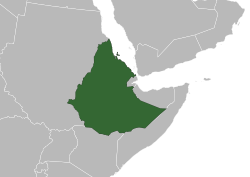Ethiopian Empire
1270–1974 state in the Horn of Africa
The Ethiopian Empire, or simply Ethiopia, also known as Abyssinia by foreigners, was an empire in East Africa. It used to include modern day Ethiopia and Eritrea. When it was biggest, it controlled some parts of Egypt, Sudan, Yemen, and Saudi Arabia. The official state religion of the empire was Ethiopian Orthodox Christianity.
Ethiopian Empire | |||||||||
|---|---|---|---|---|---|---|---|---|---|
| 1270–1974 1936–1941: Government-in-exile | |||||||||
| Motto: ኢትዮጵያ ታበፅዕ እደዊሃ ኀበ እግዚአብሔር Ityopia tabetsih edewiha ḫabe Igziabiher (English: "Ethiopia Stretches Her Hands unto God") (Psalm 68:31) | |||||||||
| Anthem: "ኢትዮጵያ ሆይ ደስ ይበልሽ" (English: "Ethiopia, Be happy") | |||||||||
 The Ethiopian Empire boundaries in 1952 | |||||||||
 The location of the Ethiopian Empire during the reign of Yohannes IV (dark orange) compared with modern day Ethiopia (orange) | |||||||||
| Capital | Mobile[note 1] (1270–1635) Gondar (1635–1855) Magdala (1855–1868) Mekelle (1871–1889) Addis Ababa (1889–1974) | ||||||||
| Common languages | Amharic (dynastic, official, court)[3][4] Ge’ez (liturgical language, literature) many others | ||||||||
| Religion | State religions: Christianity (Ethiopian Orthodox Church) | ||||||||
| Demonym(s) | Endonym: EthiopianExonym: Abyssinian | ||||||||
| Government | Absolute monarchy (1270–1931)[5] Unitary parliamentary constitutional monarchy (1931–1974) | ||||||||
| Emperor | |||||||||
• 1270–1285 (first) | Yekuno Amlak[6] | ||||||||
• 1930–1974 (last) | Haile Selassie | ||||||||
| Prime Minister | |||||||||
• 1909–1927 (first) | Habte Giyorgis | ||||||||
• 1974 (last) | Mikael Imru | ||||||||
| Legislature | None (rule by decree) (until 1931) Parliament (1931–1974)[7] | ||||||||
| Senate (1931–1974) | |||||||||
| Chamber of Deputies (1931–1974) | |||||||||
| Historical era | Middle Ages to Cold War | ||||||||
• Ascension of Yekuno Amlak | 1270 | ||||||||
• Conquests of Amda Seyon I | 1314–1344 | ||||||||
• Ethiopian–Adal War | 1529–1543 | ||||||||
• Gondarine period | 1632–1769 | ||||||||
• Zemene Mesafint | 1769–1855 | ||||||||
• Menelik's Expansions | 1878–1904 | ||||||||
| 1895–1896 | |||||||||
• Constitution adopted | 16 July 1931 | ||||||||
• Second Italo-Ethiopian War (annexed into Italian East Africa) | 3 October 1935 | ||||||||
• Sovereignty restored | 5 May 1941 | ||||||||
• Coup d'état by the Derg | 12 September 1974 | ||||||||
| 21 March 1975[8][9][10][11] | |||||||||
| Area | |||||||||
| 1344 | 1,500,000 km2 (580,000 sq mi) | ||||||||
| 1954 | 1,221,900 km2 (471,800 sq mi) | ||||||||
| Currency |
| ||||||||
| |||||||||
Abyssinia was mentioned in Egyptian records in 980 BC. Its king made the country Christian in the 4th century. The Solomonid dynasty ruled from 1270 to 1974 A.D., when it was overthrown by communists. At the time of its overthrow, it was the longest-lasting government in the world and one of the only two nations that did not get colonized in Africa.

In other languages
Ethiopian Empire:
- Ge'ez Script: የኢትዮጵያ ንጉሠ ነገሥት መንግሥተ, Mängəstä Ityop'p'ya
Ethiopia:
Notes

References
🔥 Top keywords: Main PageSpecial:Search0Slash (punctuation)BlackSpecial:RecentChanges4 (number)DavidSOLID (object-oriented design)Wikipedia:AboutFile:Sexual intercourse with internal ejaculation.webmHelp:ContentsHelp:IntroductionLisa Sparxxx2023 UEFA Champions League FinalColour24-hour clockAdolf Hitler UunonaBismillahir Rahmanir Raheem6 (number)T. N. SeshanFile:ASCII-Table-wide.svg20 (number)Poor Things (movie)United StatesCristiano RonaldoList of people who have walked on the MoonAli Malikov50 (number)17 (number)The Valley (2024 TV series)GrassList of mathematical symbolsList of U.S. states and territories by time zone8 (number)List of countries by areaWikipedia:Simple talkList of largest Hindu templesRama



